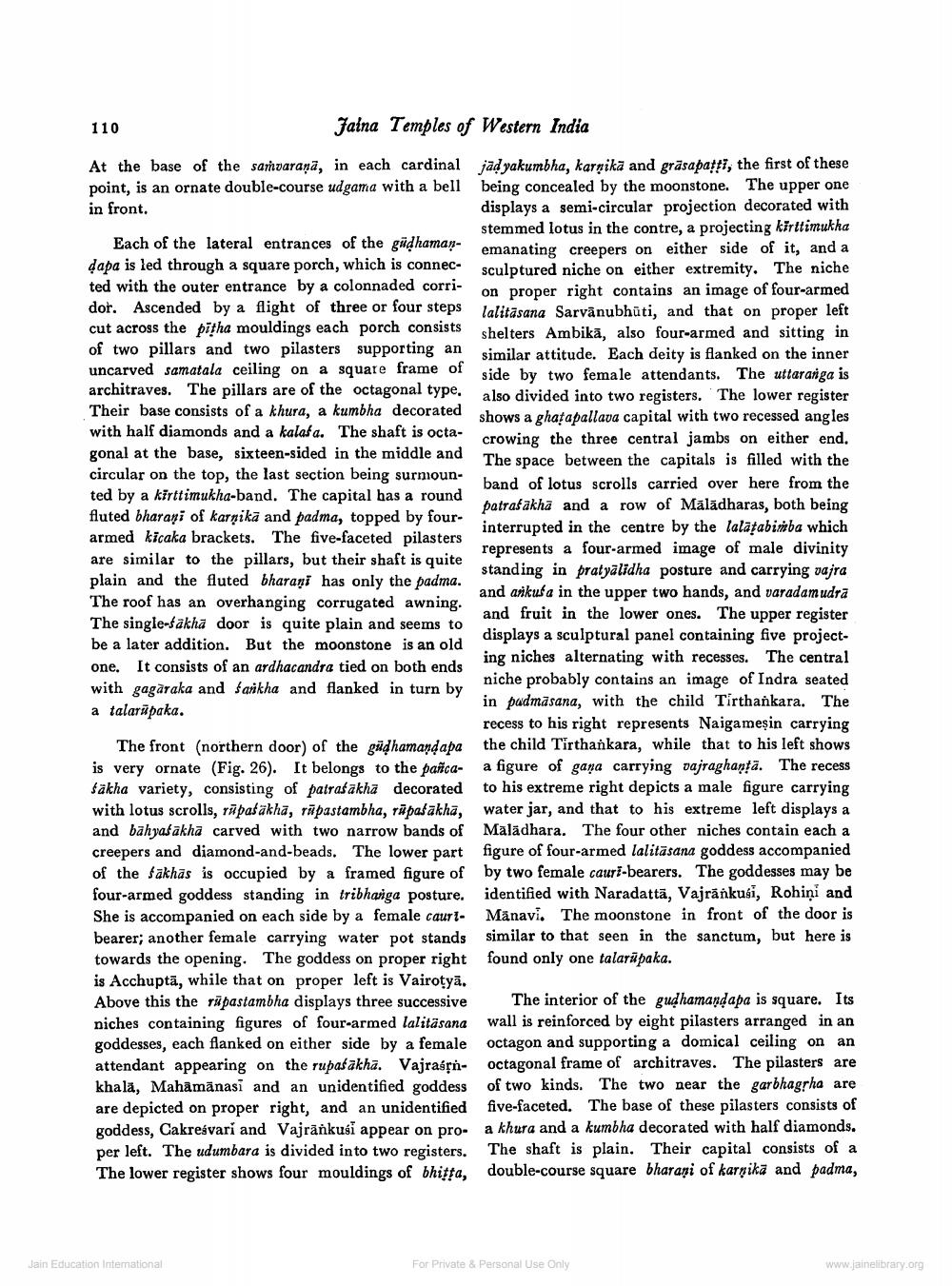________________
110
Jalna Temples of Western India
At the base of the samvarana, in each cardinal jad yakumbha, karnika and grāsapatti, the first of these point, is an ornate double-course udgama with a bell being concealed by the moonstone. The upper one in front.
displays a semi-circular projection decorated with
stemmed lotus in the contre, a projecting kiritimukha Each of the lateral entrances of the güdhaman
emanating creepers on either side of it, and a dapa is led through a square porch, which is connec
sculptured niche on either extremity. The niche ted with the outer entrance by a colonnaded corri
on proper right contains an image of four-armed dor. Ascended by a flight of three or four steps
lalitāsana Sarvānubhūti, and that on proper left cut across the pitha mouldings each porch consists
shelters Ambikā, also four-armed and sitting in of two pillars and two pilasters supporting an similar attitude. Each deity is flanked on the inner uncarved samatala ceiling on a square frame of
side by two female attendants. The uttaraniga is architraves. The pillars are of the octagonal type. also divided into two registers. The lower register Their base consists of a khura, a kumbha decorated
shows a ghatapallava capital with two recessed angles with half diamonds and a kalata. The shaft is octa
crowing the three central jambs on either end. gonal at the base, sixteen-sided in the middle and
The space between the capitals is filled with the circular on the top, the last section being surmounted by a kirttimukha-band. The capital has a round
band of lotus scrolls carried over here from the
patrašakha and a row of Maladharas, both being fluted bharaṇi of karnikā and padma, topped by four
interrupted in the centre by the lalatabimba which armed kicaka brackets. The five-faceted pilasters
represents a four-armed image of male divinity are similar to the pillars, but their shaft is quite
standing in pratyālidha posture and carrying vajra plain and the fluted bharani has only the padma. The roof has an overhanging corrugated awning.
and arkusa in the upper two hands, and varadamudra The single-sakha door is quite plain and seems to
and fruit in the lower ones. The upper register be a later addition. But the moonstone is an old
displays a sculptural panel containing five projectone. It consists of an ardhacandra tied on both ends
ing niches alternating with recesses. The central with gagaraka and Sankha and flanked in turn by
niche probably contains an image of Indra seated a talarūpaka.
in padmasana, with the child Tirthankara. The
recess to his right represents Naigameşin carrying The front (northern door) of the güdhamand apa the child Tirthankara, while that to his left shows is very ornate (Fig. 26). It belongs to the pañca- a figure of gana carrying vajraghanța. The recess Śäkha variety, consisting of patrašakha decorated to his extreme right depicts a male figure carrying with lotus scrolls, rāpašakha, tāpastambha, tāpatakha, water jar, and that to his extreme left displays a and bāhyaśākha carved with two narrow bands of Mālādhara. The four other niches contain each a creepers and diamond-and-beads. The lower part figure of four-armed lalitāsana goddess accompanied of the fākhās is occupied by a framed figure of by two female cauri-bearers. The goddesses may be four-armed goddess standing in tribhaiga posture. identified with Naradattā. Vajrånkusi, Rohini and She is accompanied on each side by a female cauri. Mänavi. The moonstone in front of the door is bearer; another female carrying water pot stands similar to that seen in the sanctum, but here is towards the opening. The goddess on proper right found only one talarüpaka. is Acchuptā, while that on proper left is Vairotyā. Above this the räpastambha displays three successive The interior of the gudhamandapa is square. Its niches containing figures of four-armed lalitäsana wall is reinforced by eight pilasters arranged in an goddesses, each flanked on either side by a female octagon and supporting a domical ceiling on an attendant appearing on the rupašakha. Vajrasrn- octagonal frame of architraves. The pilasters are khala, Mahämänasi and an unidentified goddess of two kinds. The two near the garbhagyha are are depicted on proper right, and an unidentified five-faceted. The base of these pilasters consists of goddess, Cakresvari and Vajränkusi appear on pro- a khura and a kumbha decorated with half diamonds. per left. The udumbara is divided into two registers. The shaft is plain. Their capital consists of a The lower register shows four mouldings of bhitta, double-course square bharaṇi of karpika and padma,
Jain Education Intemational
For Private & Personal Use Only
www.jainelibrary.org




